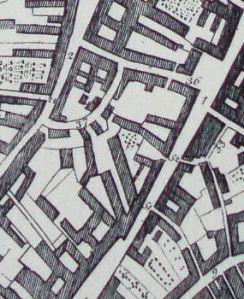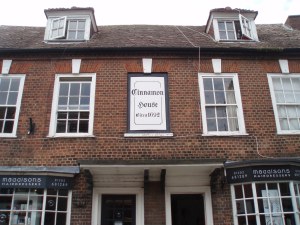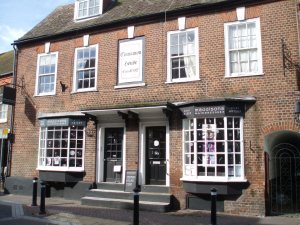While delving into the 18th century records and trying to identify who lived where in the High Street, I came across two households who probably lived at Nos. 24 and 26 (now known as Cinnamon House) in 1777. It’s difficult to be sure because I am working from a list of names with only a few fixed points. This inspired me to try to find out more about the history of the building and the site.
In the 18th century, Cinnamon Lane did not extend behind all the houses on lower High Street. Instead it was just a short lane curving round from new Street to Church Street. The first reference to the site of the building that I can find is in H. P. Smith’s History of the Borough and County of the Town of Poole when he is describing the visit of Charles II in 1665. The mayor who welcomed the King was Peter Hall, a wine cooper who ‘lived in an old stone built house on the site now occupied by Nos. 24 and 26 High Street. Indeed the original stone-walled cellar of the house still exists beneath the present premises.’ (I would love to know how H. P. Smith identified this house!) The house was not apparently fine enough to entertain the King but Peter Hall did pay for the royal luncheon in Peter Hiley’s house in the corn market. He also had the honour of handing the King ashore after his trip round Brownsea and leading the procession to William Skutt’s house for the second fine meal of the day.
So sadly it seems that the present Cinnamon House probably does not date from c. 1692 as it says on the plaque, but its cellars might be considerably older than that. According to the Royal Commission volume on Poole’s architecture, the building was constructed in the mid 18th century as a pair of brick built houses with two storeys, cellars and attics. They also mention an original fitted cupboard with partially glazed doors in the front room of No. 24. The mid 1700s was certainly a period when there was a great deal of building and rebuilding in the High Street as the population expanded dramatically.
In 1751 the house on this site may have been the home of Mr Spence Young who had a bakehouse. Later it was occupied by Robert Young and from 1761 a second house or tenement on the site is listed. Was it at this time that the old house was replaced by the present building? Robert Young was a sea captain involved in the Newfoundland trade and may often have been away at sea. In 1766, a shoemaker called Tilsed occupied the second house and by 1768, the tenant was a cooper called Adams Wadham.
Shortly afterwards, the whole building seems to have been bought by Joseph Brassett, stationer and bookseller whose shop was more or less directly opposite. Besides books and stationery he also sold drawing instruments, musical instruments and patent medicines and ran a lending library at 3d per volume per week. Adams Wadham was Joseph Brassett’s son in law and he and his wife Mary occupied one of the houses while the other was let to Samuel Marder, a silversmith. Joseph continued to live over his shop across the road. When he died in 1784, Joseph Brassett left the house to Mary.
Then the trail goes cold (if in fact it’s not been a false trail all along). Benjamin Wadham, cooper is listed in Pigot’s Directory of 1823 and Samuel Marder, merchant’s clerk in the 1841 census. They may be descendents. The next information comes from the census of 1861 when No. 24 was occupied by Mary Ann Whittle, a widow of independent means whose income derived from property. She lived there until at least 1891 with her niece, Mary E Willis. After her death, the younger Mary continued to live there until 1930. Meanwhile No. 26 was not lived in for most of the time (although it might have been a lock-up shop). In 1901, it was the home of William Mizen, basket maker, his wife Fanny and their six children. In 1911, Edward Barker lived there with his wife and family of four. He was described as a ‘jailer’ and must have worked at the Poole prison.
In 1931 Joseph Freeborn set up at No. 24 as a plasterer and later a builder. From 1967, it was a hairdresser’s, run by C. P. Evripidou and today it is Madison’s Hairdressers. The shop at No. 26 was kept by Frederick and later Miss Florence Gritten from the 1920s right through to the 1970s when it became Kernel’s gift shop. Does anyone remember these traders? Today, the building is still one of the most striking properties in the street with its handsome facade and two stepped entrances.
Jenny




Hi Jenny, I’ve only just discovered this blog and as a native of Poole – though I’ve lived away for years – I’m loving reading your fascinating research about my home town. In this particular entry I’m very interested in the “shoemaker called Tilsed” who occupied the second house. I don’t think he’s a direct ancestor of mine, but I’m trying to pull together as much Tilsed information as I can. I’m guessing the man you mention is one John Tilsed, Cordwainer, who married Jane Trim in Poole 1759. She was “of Poole” while he was a “Sojourner in Poole”.
After christening children John (who must have died young although I can’t find the burial), Ann, Thomas, James and John in Poole – the last-named in February 1767 – the family seems to have moved to Wimborne, whence they were removed back to Poole in November 1767.
I wondered if you have any information about how long they were at the second house? I can only speculate that it was perhaps the failure of the business that led them to Wimborne, where they were not allowed to stay – John presumably had settlement in Poole by then.
After John and Jane returned to Poole they christened four more children: William, Jane, Joseph and Mary, but in 1779 as far as I can tell both parents died – John in April and Jane in October.
Their daughter Jane was placed out on a parish apprenticeship in November 1780 at the age of eleven, and I am reasonably sure that son William is “William Tilsed of Lamaline in the Island of Newfoundland Seafaring man” who wrote his will in Newfoundland in 1813, leaving fifty-two pounds ten shillings to the poor of Poole in an age where it was no longer common to leave money to the poor.
It’s also possible that this John Tilsed, Cordwainer, is the one who was listed in the Corfe Castle Militia in 1759, who took on Will Beach as an apprentice in 1763, and who was convicted of assault on one James Norman, shopkeeper, in December 1763.
To Kim –
Sorry I have taken a bit of time to reply to your interesting comment on ‘Cinnamon House’. The reference to Tilsed came from a poor relief rating list known as the ‘Church and Marshalsea Rate’ for 1766. Unfortunately it doesn’t give a first name but just says ‘Tilsed Shoe maker per Personal’. In other words he was living nearby but only paying the personal rate, not the rate for a property. He was not there in the previous list (for 1765) and had gone by the date of the next list (1768).
I’ve also just found a reference to the death of Thomas Tilsed, perhaps the son of the family, who was a sailmaker in Poole. This is a notice in the Salisbury and Winchester Journal for 31st May 1802 calling for any debtors or creditors to settle up with his estate.
Do you know the Poole History Online website of the Poole Museum? There are several references and pictures of Tilseds on there. Try: http://www.poolehistory.org.uk and search on the name. I think that Captain Tilsed was master of one of the local paddle steamers. If you are ever in Poole a visit to the History Centre in the museum might be useful. – Sorry if I am telling you things that you are already well aware of! I hope this is some help.
Jenny
Only just found this (from Jon White listing it on Memories of Poole). I lived in the house (the alleyway by the side of Cinamon House) which sits by the side/behind 24/26 the high street (26a) and knew the barbers and the Colonel during the 70’s, my mother made the bear that sat in the shop. It was a great time living in the high street, my mother worked at Ridouts (otherside of the road) and remember the excavation work well. Tracy
Highly descriptive blog, I liked that a lot. Will there be a part
2?
I don’t know about Part 2 (unless I can come up with something new). However I have discovered where H.P. Smith got his information about it being the house of Peter Hall, the Mayor in 1665. It comes from ‘The History of the Town and County of Poole; compiled from Hutchins’s History of Dorset . . . with many additions and corrections by the editor’. This was published by High Street stationer, Joseph Moore in 1788. He says: ‘Peter Hall was a cooper by trade, and lived in High Street, the second house from the George Inn; at this present time the New Antelope, opposite Bell Lane, which house being rebuilt, is now occupied by Mr. William Wise and Mr. James Furnell.’
Hi friends, pleasant article and good arguments commented at
this place, I am in fact enjoying by these.
Just found this site as advised by Jenny from the Museum. I lived at 16 High street from 1945 to 1953, and my parents kept the shop until 1998 ish although it was rented out to various people. I also had my saturday morning job there and when we had it our back door went to Cinnamon lane. The Gritten sisters had a sweet shop, which also sold Toffee apples, used comics and Paraffin (all in the same shop) and you can guess where our pocket money went.
Jo Freeborn was a smashing fellow, he had a WW2 army truck and used to take us kids who lived in Cinnamon lane out on a drive to whitecliffe in the back of the lorry for a day on the grass and the sea. We also used to play in the cloth store of Walter Shaw’s scrapyard on the High street.
Just to let you know number 26 and Florence Gritten was my great aunt and she lived in the house along with her sisters Elsie Edmunds and Lillian Mitchell. My mum and all her siblings were born there. As a little girl I Remember visiting and spending time in the kitchen which had a range and the toilet was outside. I remember the shop very well as it had sweets and comics in it . Went today and it is still a shop which is now called Lavender Moon .